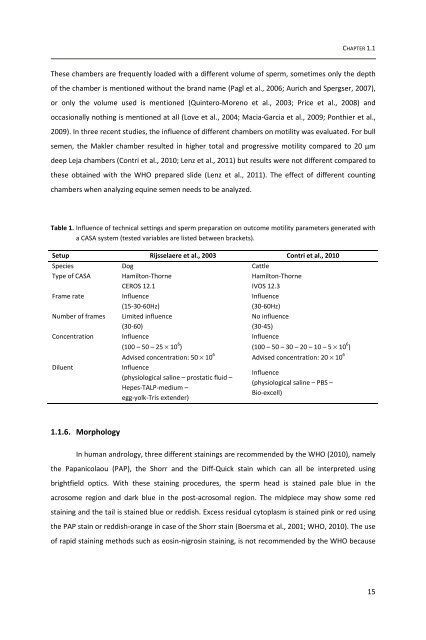view - Department of Reproduction, Obstetrics and Herd Health
view - Department of Reproduction, Obstetrics and Herd Health
view - Department of Reproduction, Obstetrics and Herd Health
Create successful ePaper yourself
Turn your PDF publications into a flip-book with our unique Google optimized e-Paper software.
CHAPTER 1.1<br />
These chambers are frequently loaded with a different volume <strong>of</strong> sperm, sometimes only the depth<br />
<strong>of</strong> the chamber is mentioned without the br<strong>and</strong> name (Pagl et al., 2006; Aurich <strong>and</strong> Spergser, 2007),<br />
or only the volume used is mentioned (Quintero-Moreno et al., 2003; Price et al., 2008) <strong>and</strong><br />
occasionally nothing is mentioned at all (Love et al., 2004; Macia-Garcia et al., 2009; Ponthier et al.,<br />
2009). In three recent studies, the influence <strong>of</strong> different chambers on motility was evaluated. For bull<br />
semen, the Makler chamber resulted in higher total <strong>and</strong> progressive motility compared to 20 µm<br />
deep Leja chambers (Contri et al., 2010; Lenz et al., 2011) but results were not different compared to<br />
these obtained with the WHO prepared slide (Lenz et al., 2011). The effect <strong>of</strong> different counting<br />
chambers when analyzing equine semen needs to be analyzed.<br />
Table 1. Influence <strong>of</strong> technical settings <strong>and</strong> sperm preparation on outcome motility parameters generated with<br />
a CASA system (tested variables are listed between brackets).<br />
Setup Rijsselaere et al., 2003 Contri et al., 2010<br />
Species Dog Cattle<br />
Type <strong>of</strong> CASA Hamilton-Thorne<br />
CEROS 12.1<br />
Frame rate Influence<br />
(15-30-60Hz)<br />
Number <strong>of</strong> frames Limited influence<br />
(30-60)<br />
Concentration Influence<br />
(100 – 50 – 25 × 10 6 )<br />
Advised concentration: 50 × 10 6<br />
Diluent Influence<br />
(physiological saline – prostatic fluid –<br />
Hepes-TALP-medium –<br />
egg-yolk-Tris extender)<br />
1.1.6. Morphology<br />
Hamilton-Thorne<br />
IVOS 12.3<br />
Influence<br />
(30-60Hz)<br />
No influence<br />
(30-45)<br />
Influence<br />
(100 – 50 – 30 – 20 – 10 – 5 × 10 6 )<br />
Advised concentration: 20 × 10 6<br />
Influence<br />
(physiological saline – PBS –<br />
Bio-excell)<br />
In human <strong>and</strong>rology, three different stainings are recommended by the WHO (2010), namely<br />
the Papanicolaou (PAP), the Shorr <strong>and</strong> the Diff-Quick stain which can all be interpreted using<br />
brightfield optics. With these staining procedures, the sperm head is stained pale blue in the<br />
acrosome region <strong>and</strong> dark blue in the post-acrosomal region. The midpiece may show some red<br />
staining <strong>and</strong> the tail is stained blue or reddish. Excess residual cytoplasm is stained pink or red using<br />
the PAP stain or reddish-orange in case <strong>of</strong> the Shorr stain (Boersma et al., 2001; WHO, 2010). The use<br />
<strong>of</strong> rapid staining methods such as eosin-nigrosin staining, is not recommended by the WHO because<br />
15









